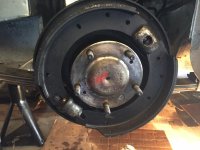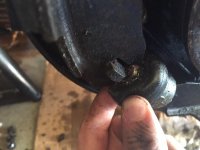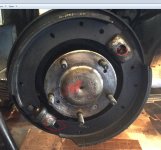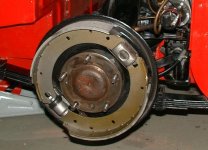... Looks like I know need a repair kid for thy cylinder...is this common? Any other suggestions while I investigate parts. I don't have much experience with drum brakes, all my cars except for my first one in high/school college have had disk brakes all around.
Yep, common (but probably not any more so than any other drum-braked car). The difference between some other makes is the cylinders are aluminum; whether or not they can be honed if pitted or scored is debatable, but new ones aren't that expensive last I checked. Compared to disk brakes, drum brakes are more complicated; there are heavy springs that have to be stretched, and more parts overall to deal with (at least Healey drums aren't self-adjusting, which adds even more bits to fiddle with). The Healey drums are what's called 'self-energizing' in that the first shoe to engage also engages the other (Wikipedia has a good explanation:
https://en.wikipedia.org/wiki/Drum_brake). For this to work, the cylinders have to be able to slide, and they're held in place by a couple of complementary clips that can be a PITA to assemble (there was a recent discussion on this forum).
Be prepared for the fact that if your cylinder was leaking--hard to tell on your photo if that's the case--the brake shoes will likely need replacing; if any fluid at all got on the shoes re-line or replace, there is no way to get all the fluid off the shoe material no matter how much you spray, soak or swear. Also, the shoes have to be adjusted so that the linings are orthogonal/perpendicular the backing plate (parallel to the axle). This is accomplished with stand-off pedestals--you'll see them when you get the shoes off--that can be screwed in or out. I know of no way besides eyeballing to make sure they are adjusted, though I've considered springing for something like this:
https://www.harborfreight.com/12-inch-digital-caliper-47261.html , in the belief that, if the linings are exactly parallel to each other they HAVE to be orthogonal to the backing. The stand-offs should have small felts on them, on which you put a drop or two of oil to aid in the shoes sliding on them.
And, and always, if one side has problems you should probably service both.




 Hi Guest!
Hi Guest!

 smilie in place of the real @
smilie in place of the real @
 Pretty Please - add it to our Events forum(s) and add to the calendar! >>
Pretty Please - add it to our Events forum(s) and add to the calendar! >> 


